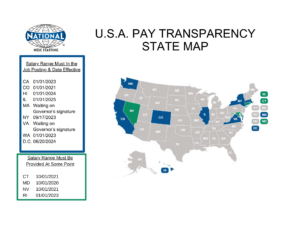
Pay transparency is a growing trend in the workplace, and more and more companies choosing to disclose salaries and compensation packages. However, this practice can have legal implications for employers, and it’s important to stay informed about the potential risks and benefits. In this guide, we’ll explore the concept of pay transparency and its impact on the workplace.
What is Pay Transparency
Pay transparency is the practice of openly sharing information about employee salaries and compensation packages within a company. This can include making salary ranges public, disclosing individual salaries, or providing employees with access to information about how their pay compares to that of their colleagues. The goal of pay transparency is to promote fairness and equity in the workplace and to help employees understand how their compensation is determined. However, there are potential legal implications to consider when implementing pay transparency policies.
Running List of States That Have Pay Transparency Laws
It’s important to note that these state laws vary by different factors, such as how many employees a company must have in order for these laws to apply. Depending on the jurisdiction, these state laws can require salary ranges to be posted in job postings, upon request, upon changing jobs within a company, or upon being hired.
The majority of this information uses SHRM or National Women’s Law Center as a resource, which we’ve found to be two of the best resources for Human Resources and Staffing. Other resources are included in the links when applicable.

NESC Staffing Map of Pay Transparency USA State Laws Regarding Job Postings
- Remote: Any job that is open to employees in these states should have the pay range in the listing.
- California – effective Jan. 1, 2023
- Colorado – effective Jan. 1, 2021 – Employers are required to put in the job listings the salary or pay range, general description of bonuses or commission, and employee benefits. As of Jan. 1, 2024, the job ad must also include the information on how to apply for the job and the application deadline for the position unless the employer accepts applications on an ongoing basis.
- Connecticut – effective Oct. 1, 2021: requires employers to provide salary range information to applicants by the time they extend an offer of compensation, even if the applicant did not request it. Employees are entitled to knowing the salary range upon hire and when changing roles, in addition to upon request.
- Washington, D.C. – effective June 30, 2024
- Hawaii – effective Jan. 1, 2024 – must include an hourly or salary range in the job posting, but that doesn’t include internal transfers, the public sector, or employers with less than 50 employees.
- Illinois – effective Jan. 1, 2025
- Maryland – effective Oct. 1, 2020
- Nevada – October 1, 2021 – Salary must be disclosed to those who complete an interview, are up for a promotion, transfer, or has been offered the position.
- New Jersey City, NJ – effective April 13, 2022
- New York – September 17, 2023 (New York City, Ithaca, and Albany County have had pay transparency laws in place since 2022.)
- Ohio:
- Cincinnati, Ohio – effective March 13, 2020
- Toledo, Ohio – effective June 25, 2020
- Pennsylvania – effective Sept. 4, 2018
- Rhode Island – effective Jan. 1, 2023 – Salaries are to be disclosed to those who are hired, when changing jobs within a company, or upon request
- Washington – Jan. 1, 2023 – Salary range, or pay scale, must be disclosed in the job posting, including recruitment done by anyone from a third party.
- Massachusetts is working on a bill promoting statewide pay transparency, but it hasn’t passed as of this writing.
- Tennessee – the Tennessee General Assembly has introduced pay transparency bills, but they haven’t passed as of this writing.
- Michigan has two bills that are currently pending.
How To Include the Pay In Your Job Postings
When posting job ads for your state, be sure to put the pay range instead of the minimum pay rate or maximum salary. For instance, “$10 and up” is not acceptable for most states, and neither is “Maximum pay rate: $50,000/annually.” To keep your job posting legal, use a pay range, either annually or hourly. For example, “$15.00-17.00/hour” or “$50,000-$70,000/annually” are both legal ways to show the pay range that can be expected at this position.
The Legal Landscape of Pay Transparency
While pay transparency can be a positive step toward promoting fairness and equity in the workplace, it is important for employers to be aware of the legal implications. In some cases, sharing salary information could violate privacy laws or anti-discrimination laws. Additionally, employers must ensure that they are not retaliating against employees who discuss their pay or attempting to discourage employees from discussing their pay. It is important to consult with legal experts and carefully consider the potential risks and benefits before implementing a pay transparency policy.
One potential legal issue with pay transparency is violating privacy laws. In some states, employers are prohibited from disclosing an employee’s personal information, including their salary, without their consent. Additionally, sharing salary information could potentially violate anti-discrimination laws if it reveals disparities based on protected characteristics such as gender or race. Employers must also be careful not to retaliate against employees who discuss their pay or attempt to discourage employees from doing so, as this could violate labor laws. It is important for employers to consult with legal experts and carefully consider the potential risks and benefits before implementing a pay transparency policy.
How to Implement Pay Transparency in a Legally Compliant Way
Implementing pay transparency in a legally compliant way requires careful planning and consideration. Employers should start by reviewing relevant laws and regulations, such as the Equal Pay Act and the National Labor Relations Act. They should also consult with legal experts to ensure that their policies and practices are in line with these laws. Additionally, employers should communicate clearly with employees about their pay transparency policy and provide training to managers and supervisors on how to handle pay discussions in a legal and appropriate manner. By taking these steps, employers can promote fairness and equity in the workplace while also avoiding legal risks.
One key step in implementing pay transparency is to establish clear guidelines for discussing pay with employees. This can include setting up regular meetings to discuss compensation and benefits, providing employees with access to salary ranges and job descriptions, and creating a process for employees to request information about their pay.
Employers should also consider implementing a system for anonymous reporting of pay discrepancies or concerns. By creating a culture of openness and transparency around pay, employers can build trust with their employees and promote a more equitable workplace. However, it is important to note that pay transparency may not be appropriate for all organizations or industries, and employers should carefully consider the potential risks and benefits before implementing such a policy.
Best Practices for Maintaining Pay Transparency in the Workplace
Maintaining pay transparency in the workplace requires a commitment to best practices. Employers should establish clear policies and procedures for discussing pay with employees, including guidelines for what information can and cannot be shared. They should also provide training to managers and supervisors on how to handle pay discussions in a legal and appropriate manner. Additionally, employers should regularly review their pay practices to ensure that they are fair and equitable, and should be prepared to make adjustments as needed. By following these best practices, employers can promote transparency and fairness in the workplace while also minimizing legal risks.
One key best practice for maintaining pay transparency is to establish clear policies and procedures for discussing pay with employees. This can include guidelines for what information can and cannot be shared, as well as protocols for how pay discussions should be initiated and conducted.
Employers should also provide training to managers and supervisors on how to handle pay discussions in a legal and appropriate manner, including how to respond to employee questions and concerns. Regularly reviewing pay practices is also important, as it can help identify any potential disparities or inequities and allow for adjustments to be made as needed.
Finally, employers should be prepared to address any legal risks associated with pay transparency, such as potential discrimination claims, by consulting with legal counsel and staying up-to-date on relevant laws and regulations. By following these best practices, employers can promote a culture of transparency and fairness in the workplace, which can ultimately lead to greater employee satisfaction and retention.
The Benefits of Pay Transparency
Help Both Employers and Employees
Pay transparency can have many benefits for both employers and employees. For employers, it can help to promote fairness and equity in the workplace, as well as increase employee trust and engagement. It can also help to attract and retain top talent, as job seekers are increasingly looking for companies that are transparent about their pay practices. For employees, pay transparency can help to reduce pay discrimination and promote equal pay for equal work. It can also help employees to better understand their own pay and how it compares to others in the organization, which can lead to increased motivation and job satisfaction.
Promote Fairness In the Workplace
One of the biggest benefits of pay transparency is that it promotes fairness and equity in the workplace. When employees know what their colleagues are earning, they are less likely to feel that they are being unfairly compensated. This can help to reduce resentment and increase trust and engagement among employees
Retain Talent
Additionally, pay transparency can help to attract and retain top talent. Job seekers are increasingly looking for companies that are transparent about their pay practices. Companies that are open about their pay can be seen as more trustworthy and desirable places to work.
Reduce Discrimination
Finally, pay transparency can help to reduce pay discrimination and promote equal pay for equal work. When employees know what their colleagues are earning, it is easier to identify and address pay disparities based on gender, race, or other factors. This can help to create a more inclusive and equitable workplace for all employees.
If you’d like someone else to handle the headaches of hiring, we’ve been assisting companies find the right employees since 1984. NESC Staffing has an A+ grade from the Better Business Bureau and has a solid record of success. You can see our latest opportunities here or contact us directly.